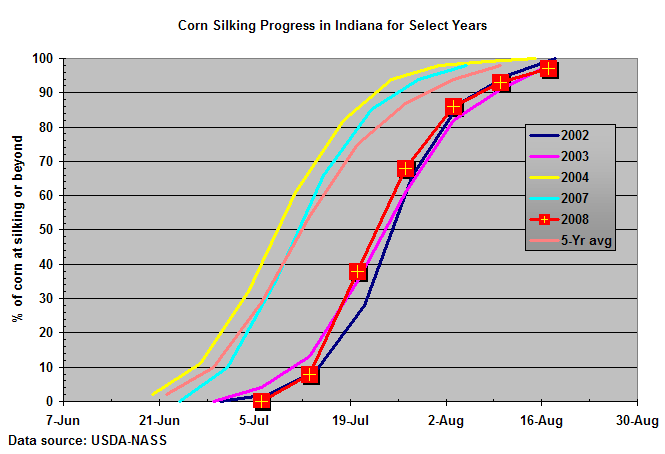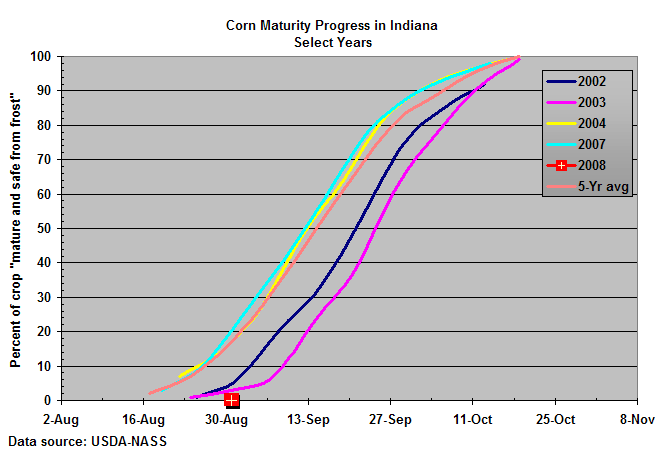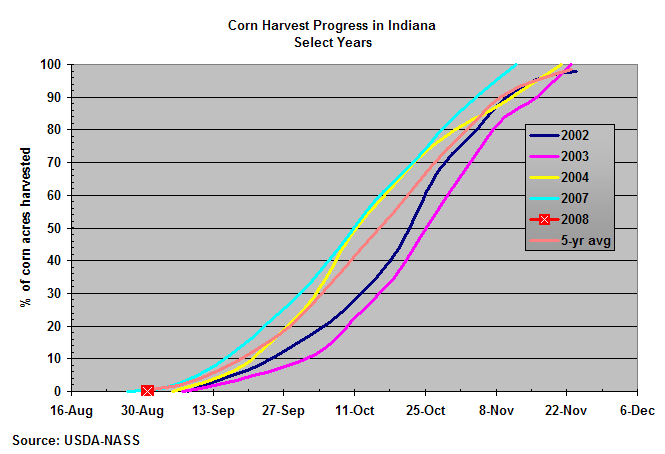Published 3 Sep 2008
URL: http://www.kingcorn.org/news/articles.08/CropProgress-0903.html
Corn Crop Continues Slow Progress
R.L. (Bob) Nielsen
Agronomy Dept., Purdue Univ.
West Lafayette, IN 47907-2054
Email address: rnielsen
at purdue.edu
![]() he
Indiana corn crop continues to lag in its race to the finish of the 2008 growing
season. The slow planting pace coupled with a relatively cool May and early
June put the corn crop about 2 weeks behind the 5-year average by the time
pollination occurred in July (Fig 1). Statewide crop progress has continued
to lag about 2 weeks behind the 5-year average throughout the grain filling
period (Fig's 2 - 3), in part due to the relatively cool temperatures throughout
much of August.
he
Indiana corn crop continues to lag in its race to the finish of the 2008 growing
season. The slow planting pace coupled with a relatively cool May and early
June put the corn crop about 2 weeks behind the 5-year average by the time
pollination occurred in July (Fig 1). Statewide crop progress has continued
to lag about 2 weeks behind the 5-year average throughout the grain filling
period (Fig's 2 - 3), in part due to the relatively cool temperatures throughout
much of August.
The progress of Indiana's corn crop to date this year has tracked closely with that of the 2003 crop. If it continues to do so, then Indiana growers can expect that crop maturity will similarly lag about 2 weeks behind the 5-year average (Fig. 4), with the latter half of the state's crop likely maturing after late September with the prospects of some of the crop possibly not maturing safely prior to a killing fall freeze (Nielsen, 2008b). Later maturity of the crop will obviously translate to a later harvest of the crop (Fig. 5).
Not only will the harvest of the 2008 crop be delayed, but grain moisture at harvest will likely be higher (Fig. 6). Grain that matures later in the season does so in a time frame that is usually relatively cooler and so daily field drydown rates will be less (Nielsen, 2008a). The prospects of wetter grain at harvest and higher fuel costs to artificially dry the grain, coupled with the higher risk of poor stalk health this year (Nielsen, 2008c) certainly dampen the spirits of many corn growers as the fall harvest season approaches. Warmer than normal temperatures throughout September would go a long ways to help this crop mature a bit sooner than expected and to facilitate more rapid field drying of the grain prior to harvest.

Fig. 1. Corn silking progress in Indiana for select years. Adapted from data
published by USDA-NASS.

Fig. 2. Percent of Indiana's corn crop at dough stage or beyond for select
years. Adapted from data published by USDA-NASS.

Fig. 3. Percent of Indiana's corn crop at dent stage or beyond for select
years. Adapted from data published by USDA-NASS.

Fig. 4. Percent of Indiana's corn crop mature and safe from frost for select
years. Adapted from data published by USDA-NASS.

Fig. 5. Percent of Indiana's corn crop harvested for select years. Adapted
from data published by USDA-NASS.

Fig. 6. Reported grain moisture content (GMC) at harvest for corn in Indiana
for select years. Adapted from data published by USDA-NASS.
Related References
Nielsen, R.L. (Bob). 2008a. Field Drydown of Mature Corn Grain. Corny News Network, Purdue Univ. [On-line]. Available at http://www.kingcorn.org/news/timeless/GrainDrying.html. [URL accessed 9/3/08].
Nielsen, R.L. (Bob). 2008b. Late Planted Corn: Enough Time to Mature? Corny News Network, Purdue Univ. [On-line]. Available at http://www.kingcorn.org/news/articles.08/DaysAfterSilk-0729.html. [URL accessed 9/3/08].
Nielsen, R.L. (Bob). 2008c. Stress During Grain Fill: A Harbinger of Stalk Health Problems. Corny News Network, Purdue Univ. [On-line]. Available at http://www.kingcorn.org/news/timeless/StalkHealth.html. [URL accessed 9/3/08].
USDA-NASS. 2008. Crop Progress. USDA Nat'l Ag Statistics Service. [On-line]. Available at http://usda.mannlib.cornell.edu/MannUsda/viewDocumentInfo.do?documentID=1048. [URL accessed 9/3/08].

